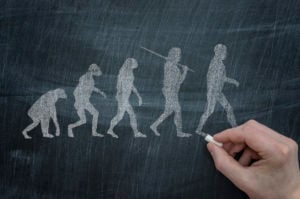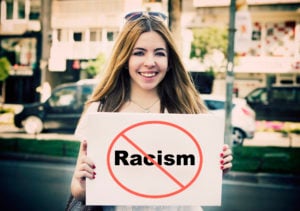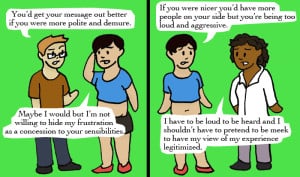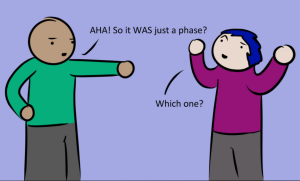
A hand holding a piece of chalk next to a blackboard with an illustration of the evolution of humans.
Sitting around the holiday table last month, I knew it was only a matter of time before my uncle and I would get into it again.
It’s become a bit of a tradition: not if, but when we will start arguing over social justice issues.
That day’s theme was race – a classic. After my uncle criticized Affirmative Action, I emphasized that people of color continue to encounter barriers – from education, to employment, to healthcare – that white folks don’t. So, Affirmative Action policies help (however imperfectly) to level the playing field.
Dismissing my sociohistorical analysis, however, my uncle problematically responded, “Well, it’s just human nature to divide the world into different races, so what can you do?”
Other family members nodded in approval, and before I could reply, my cousin jumped in with a funny story about her two-year-old daughter.
The idea of “human nature,” that certain biological or genetic traits predispose all humans to particular behaviors, is quite widespread. And many people evoke it in order to explain social inequality.
Only, here’s the thing: We completely misunderstand human nature.
And rather than explaining inequality, the concept frequently serves to justify it instead.
What Is ‘Human Nature?’
Human nature is not a biological concept.
Nonetheless, as faux science at its finest, human nature suggests that all humans can (and should) be reduced to a single “ideal type.” (And guess what. Anything that doesn’t match that ideal therefore becomes “unnatural.”)
Essentially, proponents of human nature argue that our genes alone determine behavior.
Consider, for example, the so-called “warrior gene.” Some people insist that one can attribute aggression to this gene. Only, the presence of this gene alone does not make someone more violent.
It is only when some individuals with this gene variant encounter social exclusion and ostracism that they express slightly higher levels of aggression.
Equivalently faulty logic influenced the development of social Darwinism, the notion that “strong” genes affect how wealthy or how professionally successful one becomes
In the early 1900s, for example, white society evoked social Darwinism to explain white folks’ relatively higher well-being compared to people of color. Strong, white genes, they claimed, made white folks healthier and more intelligent, whereas weak, black genes made people of color sickly.
People of color’s “genetic inferiority” also served to justify white folks’ continued oppression of Black and Brown people.
After all, why should people of color be allowed to own property, vote, or get an education if they’re “naturally” inferior to their white counterparts?
Significantly, few white folks identified the social or political disenfranchisement of people of color as factors influencing these racial differences.
Throughout the history of the US, privileged groups similarly highlighted social Darwinism in order to validate genocide against Native Americans; the enslavement of Africans, indigenous peoples of Central and South America, and Asians; the political and economic disenfranchisement of women; the internment of Japanese residents; the incarceration and sterilization of LGBTQIA+ folks; the forced institutionalization of people with disabilities; and so on.
And today, without necessarily citing social Darwinism, many folks continue to use equivalent arguments in order to justify contemporary oppression.
For instance, police officers regularly justify the murder of Black men by referencing the supposedly hardwired Black male aggressiveness and strength, calling their victims “brutes,” “animals,” “the Hulk,” and so on.
Ongoing political economic and social marginalization reinforces today’s inequality, not some form of biological innateness.
However, many people continue to problematically talk about human nature.
One reason for this is continued misunderstandings surrounding evolution and human origins.
A Very Brief Discussion of Human Origins
What is human nature? Well, that depends on what we even mean by “human” in the first place.
Do we mean those complex characteristics that we claim are unique to Homo sapiens – traits like abstract thought, tool making, art, and language? Well, the great apes and dolphins express many of these traits, too.
Do we mean genes? Well, considering the interbreeding between humans and Neanderthals (and thus the existence of Neanderthal DNA among contemporary humans), the question of who or what humans are genetically isn’t exactly clear-cut either.
Chimpanzees are humans’ closest living relatives. But they are often inaccurately used as a proxy for our “primitive ancestor.” For example, many emphasize chimps’ aggression (while disregarding their compassion) to justify humans’ supposedly natural aggressive tendencies.
But we must remember: Humans and chimpanzees share a common ancestor. Humans aren’t chimps, nor did humans evolve from them.
Most significant for understanding human diversity, however, is that humans evolved most of our “complex” traits – those traits that supposedly make us “human” – before migrating out of Africa around 200,000 years ago.
In other words, humans were already “fully cooked” before encountering the different habitats around the world that influenced the development of external physical differences like skin color, hair texture, eye shape, and hip size.
Breaking Down Human Nature
Human nature identifies particular characteristics that are supposedly “natural” among humans. One of the most misunderstood characteristics is our tendency to categorize the world.
Of course, we do categorize the world: edible vs. non-edible and kin vs. non-kin are two examples. But it’s crucial to remember that while the act of categorizing might be a human universal, the categories themselves (or rather, what’s included in those categories) are not!
Humans might divide the world into edible and non-edible. But we certainly can’t agree on what falls into each category.
Is pork edible? What about bugs? Foie gras? Animal products in general?
We can’t even agree on why we don’t agree on what falls into each category. Is it because of religious prohibitions? Cultural taboos? Animal rights? Environmentalism?
So, while it might be “natural” to organize our world, how we do so and the value that we add to each category is entirely social.
Let’s briefly examine some of the most common social categories.
1. Race
Scientists and doctors problematically used race as equivalent to subspecies. Under this framework, each race might have different innate characteristics.
However, race is not biologically determined.
There are no racial genes or genetic sequences that are unique to people of different races. There is no one biological trait (or set of traits) that is completely unique to people racialized as white, Black, Latinx, and so on.
What’s more, how we even differentiate race changes from society to society. The traits that we use to racialize someone as white (or non-white) in the US, for example, are not the same as those in Brazil, in Mali, or in China.
The characteristics that a given society attributes to particular racial groups, therefore, are the product not of biological factors, but of historical, political, economic, and social ones.
Crucially, however, while race isn’t biological, that doesn’t mean that race isn’t important or that it doesn’t have biological effects.
Indeed, ongoing white supremacy has reinforced structures that negatively influence the health, nutrition, and life expectancy of people of color.
2. Gender
Women are just innately more nurturing and better at cooking, right? Just like men are just innately more aggressive and adept at math and sciences.
“Human nature” justifies different expectations among people gendered as men or women.
This notion is based on multiple misunderstandings.
It conflates gender (a culturally situated set of roles, performances, and expectations) and sex (biological differences among humans, mainly concerning reproduction).
Gender is a social construct rooted in problematic conceptions of sex as a binary. Biological sex, however, occurs on a continuum and is the product of multiple developmental processes.
For example, consider (without pathologizing!) intersex individuals who are genetically neither XY or XX, but XXY. Or those with ambiguous genitalia.
That we even consider sex (and thus gender) as a binary biological reality is the product of historical Euro-American cultural and religious notions that claim that sex is a binary, despite biological evidence to the contrary.
In other words, notions of gender influence notions of sex, and vice versa.
Nonetheless, many people believe that men and women are intrinsically different in terms of behaviors, desires, and dispositions. But this certainly isn’t true. (Neither is the reductive division of humanity into only “men” and “women,” neglecting the millions of individuals who do not cleanly fit into those categories.)
Ongoing patriarchy – glossed over as human nature – reinforces male supremacist structures that oppress women and intersex folks.
3. Sexuality
Many people claim that heterosexuality and monogamy are the only “natural” expressions of sexuality.
Conveniently, the same folks who cite apes as evidence of humans’ (especially human men’s) apparently innate aggressiveness ignore the sexual diversity found among chimpanzees, bonobos, and gorillas.
Again, humans are not chimps.
But it is worth noting that our closest living relatives regularly engage in homosexuality and having multiple partners, not to mention other sexual practices often considered “unnatural” among humans.
This includes masturbation, oral and anal sex, group sex, inter-generational sex, and so on.
Social justice advocates have long highlighted that heterosexuality and monogamy’s supposed naturalness is actually very much a social phenomenon, primarily based upon narrow and oppressive notions of “moral” behavior.
4. Class
Many, particularly those with wealth, justify increasing income inequality through the problematic notion of “might makes right.” They equate richness with natural selection.
That is, people of lower socioeconomic status supposedly deserve their fate because they are not as “fit” or evolved as those privileged enough to be middle or upper class.
However, one can’t apply evolutionary theory to human social systems.
Naturalizing economic disparities presumes the biological innateness of particular human behaviors, including competition, violence, alienation, apathy, and aggression.
We should resist attempts to reductively equate biology or genes with particular practices.
We should also consider human behaviors and values often excluded from this framework, behaviors like sharing and mutual assistance.
Income inequality, in other words, is not the product of “human nature” – but it is the product of capitalism!
Rethinking Human Nature: What Do We Share, Anyway?
“Human nature,” as popularly evoked, reinforces oppression because it justifies it.
Human nature hides marginalizing historical and social structures beneath a veneer of fake science.
Rather than entirely ridding ourselves of the notion, however, we should rethink what we consider to be “natural” among humans in the first place. Humans and our ancestors would not have survived if we were the innately violent, competitive species we are often thought to be.
What all human communities have long had in common has been our propensity towards cooperation and sharing, as well as our abilities to express compassion and empathy.
Think about it: How else would we have developed and disseminated sophisticated ideas – concerning art, tool use, medicine, and so on – had we not collaborated as individuals and communities?
Of course, this isn’t to say that there is no evidence of violence throughout our development as a species. However, we mustn’t overemphasize such violence.
Consider, for example, widespread archaeological evidence of humans tending to sick, injured, and elderly individuals who would have perished had they been abandoned.
Cooperation and sharing are key traits among non-human primates, too. Though, clearly, humans do it with style!
There is very little (genetically or behaviorally) that is absolutely unique to humans.
What is unique, however, is the extent to which we engage in certain practices, plus the cultural transmission of knowledge to the next generation.
Humans are remarkably genetically similar compared to many other species. But we demonstrate a vast amount of cultural diversity.
In many respects, therefore, human nature is culture.
[do_widget id=’text-101′]
Andrew Hernández is a Contributing Writer for Everyday Feminism. He is a public anthropologist and teacher, completing his PhD in cultural anthropology at the Graduate Center, City University of New York. Andrew bases his research out of West Africa and the Sahara, working on issues of human rights, crisis and religion. A former adjunct lecturer, he is now a Professional Teaching Fellow at the University of Auckland in New Zealand. You can follow him on Twitter @AndrewHernann or at his website. Read her articles here.
Caitlin Bonham Smith is completing her PhD in Biological Anthropology at the University of Auckland, New Zealand. Caitlin works in both Australia and Bahrain, exploring the health and diet of past peoples. In addition to research, Caitlin teaches labs on topics such as human evolution and human biology.
Search our 3000+ articles!
Read our articles about:
Our online racial justice training
Used by hundreds of universities, non-profits, and businesses.
Click to learn more
Most Read Articles
- « Previous
- 1
- …
- 30
- 31
- 32



















